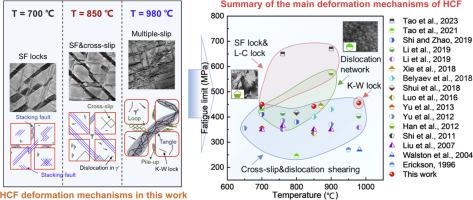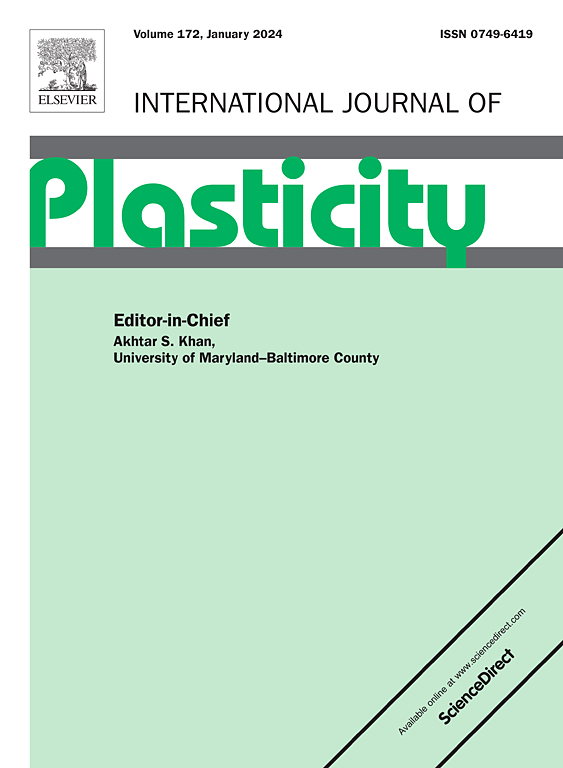Temperature-dependent microscopic deformation mechanisms and performance enhancement prospects in high-cycle fatigue of nickel-based single crystal superalloys
IF 9.4
1区 材料科学
Q1 ENGINEERING, MECHANICAL
引用次数: 0
Abstract
Given the limited systematic analysis of microstructural deformation mechanisms in high-cycle fatigue, this study investigates the high-cycle fatigue failure of a fourth-generation nickel-based single crystal superalloy across temperatures of 700 °C, 850 °C, and 980 °C. The results indicate that the alloy exhibits optimal performance at 980 °C, followed by 700 °C and then 850 °C. At 700 °C, stacking fault locks and Lomer-Cottrell dislocations were identified, whereas, at 850 °C, elongated stacking fault shearing and typical cross-slip were observed. Notably, at 980 °C, intense dislocation activity was detected, including Kear-Wilsdorf locks, dislocation pile-up, and entanglement. The observed changes in microstructural mechanisms with increasing temperature are attributed to elevated stacking fault energy and critical shear stress, alongside reduced critical stress for various dislocation movements. Furthermore, the types of Lomer-Cottrell dislocation and Kear-Wilsdorf lock were accurately identified. In conclusion, the dominant micro-deformation mechanisms—stacking fault locks, Lomer-Cottrell dislocations, and dislocation hardening behaviors such as Kear-Wilsdorf locks—significantly enhance high-cycle fatigue performance. This research addresses the scarcity of studies on microscopic deformation mechanisms in single crystal high-cycle fatigue and provides valuable insights for optimizing the high-cycle fatigue performance of nickel-based superalloys.


镍基单晶高温合金高周疲劳温度相关显微变形机制及性能增强前景
鉴于对高周疲劳中微观组织变形机制的系统分析有限,本研究研究了第四代镍基单晶高温合金在700°C、850°C和980°C下的高周疲劳失效。结果表明,该合金在980℃时性能最佳,其次是700℃和850℃。在700°C时,发现了层错锁和lomo - cottrell位错,而在850°C时,发现了拉长的层错剪切和典型的交叉滑动。值得注意的是,在980°C时,检测到强烈的位错活动,包括基尔-威尔斯多夫锁、位错堆积和纠缠。观察到的显微组织机制随温度升高的变化归因于层错能和临界剪应力的升高,以及各种位错运动的临界应力的降低。此外,准确地识别了lomo - cottrell位错和Kear-Wilsdorf锁的类型。综上所述,主要的微变形机制——层错锁、lomo - cottrell位错和位错硬化行为(如Kear-Wilsdorf锁)——显著提高了高周疲劳性能。该研究解决了单晶高周疲劳微观变形机制研究的不足,为优化镍基高温合金高周疲劳性能提供了有价值的见解。
本文章由计算机程序翻译,如有差异,请以英文原文为准。
求助全文
约1分钟内获得全文
求助全文
来源期刊

International Journal of Plasticity
工程技术-材料科学:综合
CiteScore
15.30
自引率
26.50%
发文量
256
审稿时长
46 days
期刊介绍:
International Journal of Plasticity aims to present original research encompassing all facets of plastic deformation, damage, and fracture behavior in both isotropic and anisotropic solids. This includes exploring the thermodynamics of plasticity and fracture, continuum theory, and macroscopic as well as microscopic phenomena.
Topics of interest span the plastic behavior of single crystals and polycrystalline metals, ceramics, rocks, soils, composites, nanocrystalline and microelectronics materials, shape memory alloys, ferroelectric ceramics, thin films, and polymers. Additionally, the journal covers plasticity aspects of failure and fracture mechanics. Contributions involving significant experimental, numerical, or theoretical advancements that enhance the understanding of the plastic behavior of solids are particularly valued. Papers addressing the modeling of finite nonlinear elastic deformation, bearing similarities to the modeling of plastic deformation, are also welcomed.
 求助内容:
求助内容: 应助结果提醒方式:
应助结果提醒方式:


